8 Semantic SEO Strategies That Will Help You Rank In 2024
If you struggle to get your site noticed despite your traditional SEO efforts, this article is here to help. With our 8 proven semantic SEO strategies, you will boost your rankings, improve visibility, and enhance user experience.
You’ll get practical steps and real-life examples to implement right away. By the end of this read, you’ll understand how to align your content with the latest search engine algorithms and user intent.
Let’s get into it.
8 Proven Semantic SEO Strategies To Rank Higher In 2024
As you read through each strategy, consider what changes can you make today to make sure your content meets the demands of tomorrow’s search algorithms?
1. Use Voice Search Optimization
Voice search drives more than $2 billion in sales. Optimize your content for voice search to meet the needs of users who rely on voice assistants for their search queries. It helps you to capture a growing segment of search traffic. Optimize your content for voice search with these 6 strategies:
1.1 Write In A Conversational Style
Use a tone and language that mimic natural speech. For example, Instead of writing “best places to visit in New York,” use “What are the best places to visit in New York?”
1.2 Focus On Long-Tail Keywords & Questions
Optimize for long-tail keywords that reflect natural speech patterns. Moreover, it’s best to rank each product page with specific long-tail keywords.
Vinyl Status is an excellent example of how to effectively use long-tail keywords to rank for specific products. For instance, they use targeted keywords like “custom stickers for water bottles” to drive relevant traffic to their product page attracting users looking for exactly what you offer.
They use these semantic keywords in their product titles, meta descriptions, and product descriptions which helps search engines understand the context and relevance of their pages.
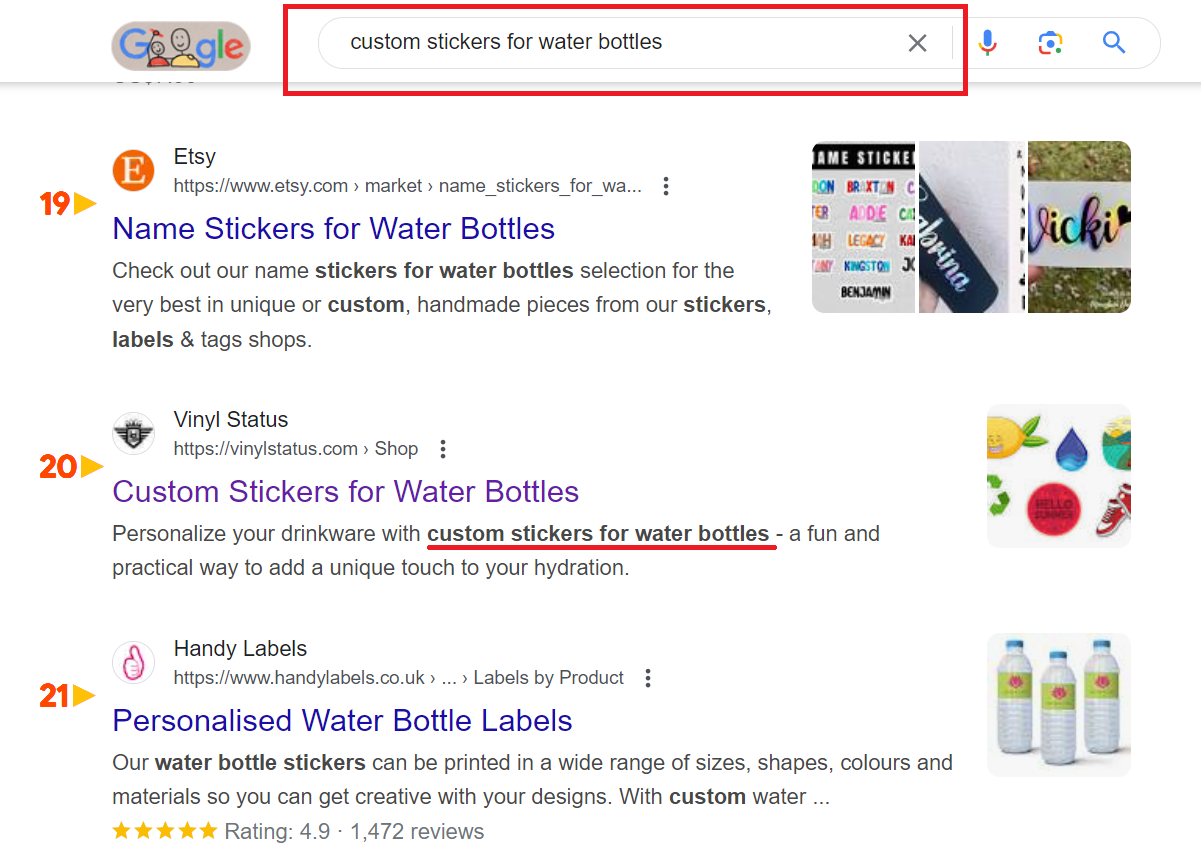
1.3 Use Question-Based Queries
Incorporate question words like who, what, where, when, why, and how into your content as many voice searches are phrased as questions. For example, “When is the best time to plant tomatoes?”
1.4 Improve Page Load Speed
Make sure your pages load in 2 seconds because voice search users expect fast responses. Also, compress your images and use descriptive file names and alt text. Lastly, leverage browser caching and content delivery network (CDN) to improve load times.
1.5 Optimize For Local Search
Many voice searches are local in nature. So, include your city or neighborhood in your keywords to optimize your content for local search. An excellent example is Pinch which effectively uses the keyword “Chicago lip filler at home” to target a specific audience searching for local services using a dedicated service page.

As a result, they rank 2nd on Google SERP for this keyword. You can replicate this strategy by identifying relevant local keywords for your business and integrating them into your content, meta descriptions, and headings. This ensures your site is visible to users searching for local services. Also, make sure your Google My Business listing is up to date to maximize your local search visibility.

1.6 Answer Common Questions
Add a frequently asked questions (FAQ) section to your website that addresses common queries about your industry or niche. For example, a fitness website can include questions like “What are the best exercises for weight loss?” with detailed answers.
2. Optimize For User Intent
Content that matches user intent is 2.5x more likely to convert. The first step is to understand why users are searching for your product or service. Then, provide content that directly answers their questions and solves their problems. Search intent can be categorized into 3 main types:
2.1 Informational Intent
Users are looking for information or answers to specific questions. For example, “How to start a blog” or “What is semantic SEO?”
What you can do:
Write comprehensive guides, how-to articles, and educational content that provides detailed answers and insights. This includes step-by-step instructions, practical examples, FAQs, and troubleshooting tips. Try to add relevant images, and videos to help them understand and apply it better.
For example, take inspiration from this great example from greenhouse accessories’ website in meeting informational user intent. They use an FAQ section to answer common questions like “Why should I buy from you instead of Costco, Amazon & Co?” and “Are you an authorized dealer?”
These FAQs often appear as rich snippets in search results, making it easy for users to find quick answers. By doing this, they improve user experience and increase visibility on search engines.

2.2 Navigational Intent
Users want to find a specific website or page. For example, “Facebook login” or “Hardware Direct homepage.”
What you can do:
Make sure your website is easy to navigate and important pages are easily accessible and well-optimized:
- Add a search bar
- Use descriptive page headings
- Have an Intuitive menu structure
- Have a Consistent website design
- Use clean URLs like “yourwebsite.com/login”
An excellent example is Bariatric Fusion, an eCommerce website that uses an accessibility menu to enhance user navigation. This menu includes features like a screen reader, contrast adjustments, text size options, and dyslexia-friendly settings.
These features ensure all users with hearing and visual impairments can easily access the site’s content.
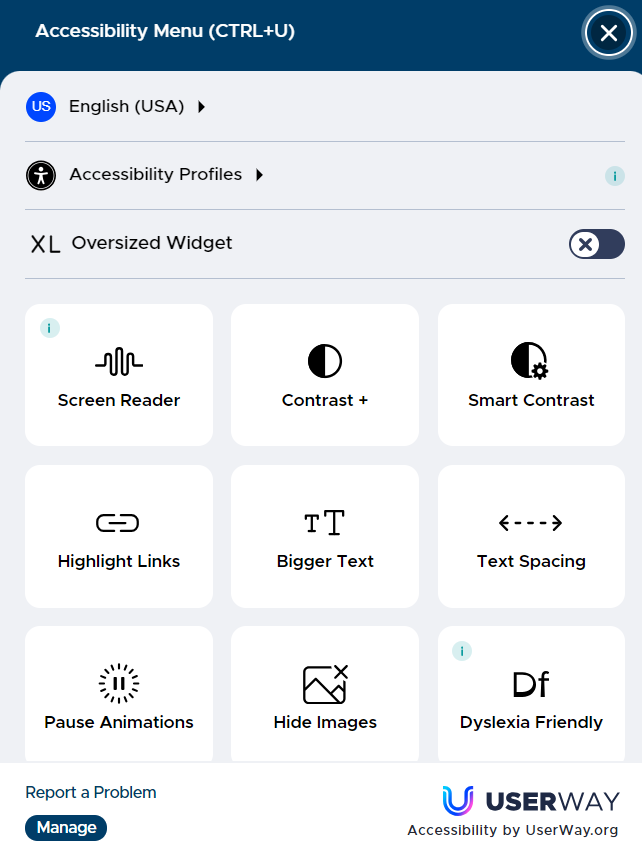
2.3 Transactional Intent
Users are looking to make a purchase or complete a specific action. For example, “buy running shoes online” or “sign up for Netflix.”
What you can do:
Include clear calls-to-action, detailed product descriptions, and easy-to-use purchase processes.
3. Use Structured Data Markup
72.6% of pages on the first page of Google use schema. Structured data can give rich snippets–search results with extra information like images, ratings, and reviews. These stand out in search results and can increase click-through rates.

Add specific tags to your HTML to provide detailed information about your pages. It makes it easier for search engines to index and display your content in search results. To use structured data markup effectively, follow these 4 strategies:
3.1 Choose The Right Schema Type
Identify the content type on your page and select the appropriate schema type from Schema.org. Here are examples:
- Articles: For blog posts and news articles.
- Products: For product pages in eCommerce sites.
- Recipes: For food and drink recipes.
- Events: For event listings.
3.2 Generate The Structured Data Markup
Use online tools to create the structured data markup for your content. You can use:
- Google’s Structured Data Markup Helper: Go to the tool and select the content type you want to markup like articles or events. Then, enter your page’s URL or paste its HTML source code. Highlight relevant information on your page, like titles or dates, and tag them using the provided options. Once done, generate the HTML and add it to your webpage’s source code.
- Schema Markup Generator by Merkle: This tool provides a user-friendly interface to create JSON-LD code for various types of content. To markup data, go to the tool and select the schema type you need, like product or recipe. Fill in the details required like name, description, and image URL. Then, create the JSON-LD code.
3.3 Add The Markup To Your HTML
Insert the generated JSON-LD code into your webpage HTML. You can do this manually or using plugins if you are using a content management system like WordPress.
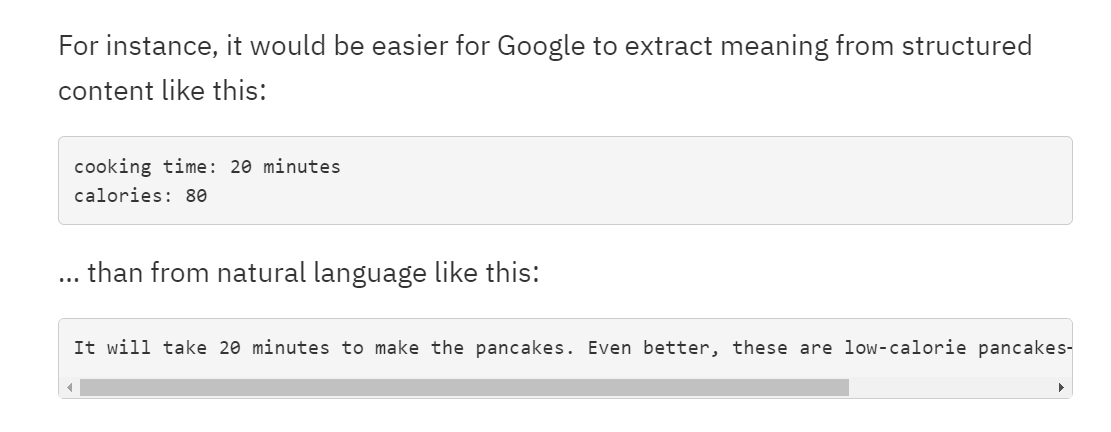
3.4 Test Your Structured Data
Use Google’s Rich Results Test to make sure your structured data is correctly implemented. Simply paste your URL or code into the tool and check for any errors or warnings. Common errors include missing required fields, incorrect data types, and improperly formatted code.
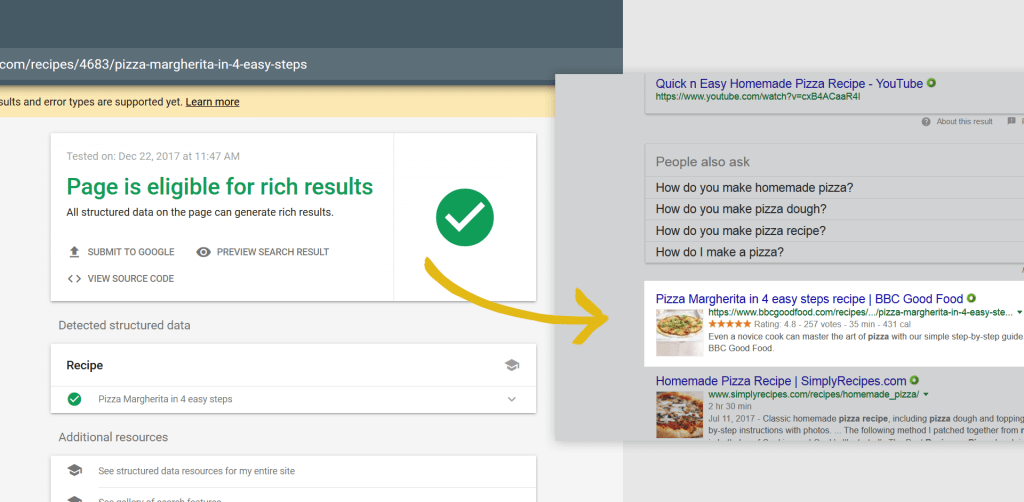
4. Create Comprehensive Topic Clusters
Creating comprehensive topic clusters can boost organic traffic by up to 40%. Topic clusters are a content strategy that groups related content around a central pillar page. The pillar page provides an overview of the broad topic, while cluster pages cover specific subtopics in more detail. They make it easier for search engines to understand the topic and for users to navigate.
Create comprehensive topic clusters with these key 5 strategies:
4.1 Identify Core Topics
Choose broad topics about your audience and business. These should be topics you can cover extensively and that have significant search volume. For example, if you run a health and wellness blog, a core topic might be “Healthy Living.” Similarly, if you operate a tech blog, a core topic can be “Latest Gadgets and Innovations.” Or, if you manage a financial advice site, you can focus on “Personal Finance Management.”
4.2 Create Pillar Pages
Develop comprehensive pillar pages that provide an overview of the core topic. These pages should be broad and informative, covering the main aspects of the topic. Let’s say for “Healthy Living,” a pillar page can cover overall lifestyle changes, including diet, exercise, mental health, and sleep.
4.3 Identify Related Subtopics
Break down the core topic into specific subtopics that you can explore in detail on separate cluster pages. Use Ahrefs, SEMrush, or Google Keyword Planner to identify relevant subtopics with good search volume. For example, subtopics for “Healthy Living” can include:
- “Healthy Eating Tips”
- “Exercise Routines for Beginners”
- “Mental Health Practices”
- “The Importance of Sleep for Health”
4.4 Create Cluster Pages
Develop detailed cluster pages for each subtopic. These pages should provide in-depth information, practical tips, and relevant examples. For the subtopic “Healthy Eating Tips,” create a page that covers meal planning, nutritious recipes, and multivitamins for specific health conditions.
4.5 Interlink Your Content
Use internal links to connect your cluster pages to the pillar page and vice versa. This helps search engines connect your pages and makes navigation easier for users.
For example, on your “Healthy Eating Tips” page, include a link back to the “Healthy Living” pillar page. Also, add links to other related cluster pages like “Exercise Routines for Beginners.”
5. Leverage Natural Language Processing (NLP)
The NLP market will increase to $43.9 billion by 2025, so it’s the right time to use it in your marketing. NLP is a branch of artificial intelligence that helps machines comprehend text and spoken words just as humans do. Search engines like Google use NLP to better understand semantic search queries and the content on web pages so you can deliver more relevant search results.
Here’s how you can use NLP to improve your SEO efforts.
5.1 Use NLP Tools
Use these 3 NLP tools to analyze and optimize your content:
- Google Natural Language API: Analyzes text to extract information about how people perceive your content. Once you paste your text into the provided demo area, the NLP tool will analyze your text and provide insights on entities (people, places, things), sentiment (positive, negative, neutral), and syntax (grammar, sentence structure).
- IBM Watson Natural Language Understanding: Provides insights into keywords, categories, sentiment, and more. All you have to do is visit the IBM tool and upload your document or enter text directly into the tool.
- OpenAI’s GPT Models: Generate human-like text and analyze content for natural language. Visit the OpenAI GPT website and give a brief prompt or paste your existing content into the tool. The tool can generate new text based on your prompts or analyze your current content for readability and engagement.
5.2 Improve Readability & Engagement
NLP can help you make your content more readable and engaging:
- Sentence Structure: Use NLP tools like Google Natural Language API to look for sentences with multiple clauses or complex structures. Then, rewrite them into shorter, clearer sentences.
- Keywords and Synonyms: Enter your text into IBM Watson to get a list of related keywords and synonyms. Incorporate these naturally throughout your content to enhance comprehensiveness.
- Sentiment Analysis: Make sure your content maintains a positive and engaging tone. Analyze your text with IBM Watson to get a sentiment score. If the score is neutral or negative, revise your content to use more positive language.
5.3 Analyze Competitor Content
NLP tools can help you analyze competitor content to understand what works well in your niche. Look for patterns in the language, structure, and topics that top-performing pages use.
For example, use IBM Watson to analyze the top-ranking articles for “digital marketing strategies” and identify common themes and structures to incorporate into your content.
5.4 Use Structured Data & Schema Markup
NLP benefits from structured data because it provides a clear context for the content. Use schema markup to help search engines understand your content better.
For example, if you have a recipe blog, use structured data to mark up ingredients, cooking times, and instructions to help search engines like Google present your content prominently in search results.
6. Improve Internal Linking Structure
Internal links are hyperlinks that point from one page on your website to another page on the same website. A well-structured internal linking system can boost organic traffic by up to 40%. So, have a solid internal linking strategy for your semantic search engine optimization (SEO) and user experience.
Internal links help search engines find and index your content faster. Here are 5 actionable strategies to create an effective internal linking structure:
6.1 Use Descriptive Anchor Text
Make sure your anchor text is descriptive and relevant to the linked page. Avoid generic phrases like “click here” or “read more.” Instead, use specific phrases like “learn more about our SEO services” or “discover healthy eating tips.”
6.2 Link To Relevant Content
Only link to pages that are relevant to the content you are linking from. For example, in a blog post about digital marketing, link to related topics like “social media marketing” or “content strategy.”
6.3 Use Siloing For Grouping Related Content
Siloing involves grouping related content and linking them within the group to create topical relevance and strengthen the overall site theme.
For example, for an eCommerce site, create silos for different product categories. A great example is Ovaeda, an eCommerce store for outdoor living products. They organize content into key categories like Outdoor Paving, Composite Gates, and Outdoor Furniture with each having detailed subcategories.
For instance, Outdoor Paving includes Porcelain Paving and Natural Stone Paving, while Outdoor Furniture covers Patio Sofas, Sofa Cushions, and Outdoor Lamps. Each subcategory page offers detailed information and links to specific products and related content.

6.4 Balance The Number Of Internal Links
Aim for a balance that provides value without overwhelming the reader or diluting the link equity. For example, a blog post of 1,500 words can include 3-5 internal links to relevant content.
6.5 Update Old Content With New Links
Regularly update your old content with links to new pages. This keeps your content fresh and helps distribute link equity to newer pages. For example, if you publish a new article on “2024 SEO Trends,” link to it from older articles on SEO.
7. Focus on Content Quality and Depth
Content that demonstrates expertise, authority, and trustworthiness (E-A-T) helps build your site’s credibility and domain authority. Search engines like Google prioritize content that thoroughly covers a topic. So, make sure your content provides valuable and comprehensive information that meets users’ needs.
Follow the key 4 steps to create quality content:
7.1 Conduct Thorough Research
- Make sure your information comes from reliable and authoritative sources.
- Update your content every 6-12 months to reflect the latest trends and data.
- Incorporate multiple viewpoints to provide a well-rounded perspective on the topic.
7.2 Understand Your Audience
- Know the problems and questions your audience has and address them directly in your content.
- Write in a language and tone that resonates with your target audience to make it more relatable and engaging.
7.3 Structure Your Content Well
- Organize your content with descriptive headings and subheadings to make it easy to navigate.
- Use bullet points and numbered lists to break up text and highlight key points.
- Incorporate images, infographics, charts, and videos to complement the text and enhance understanding.
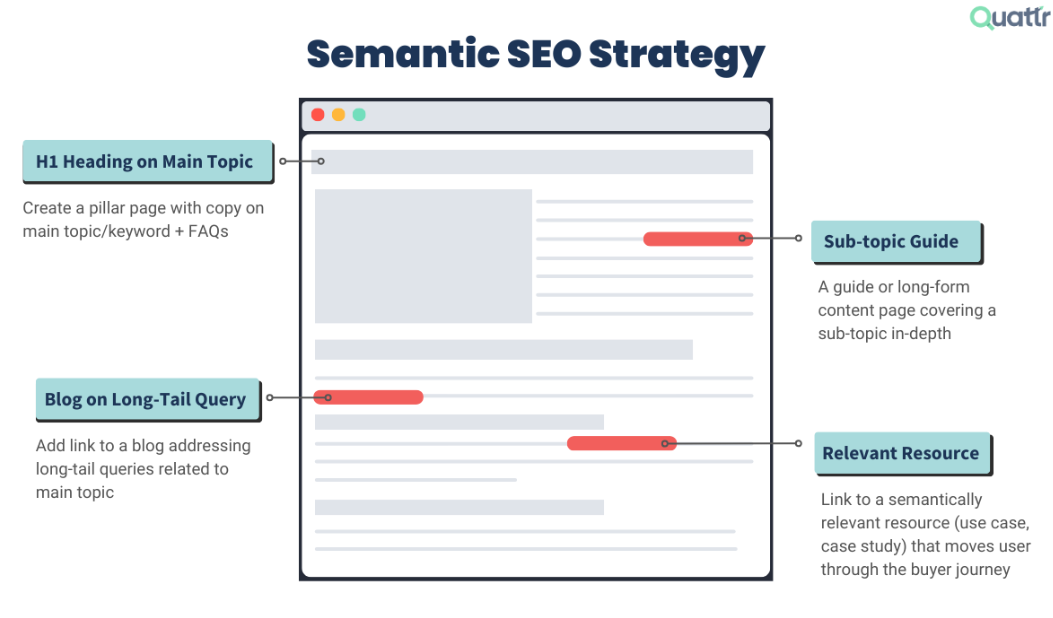
7.4 Optimize For Readability
- Keep paragraphs to 2-3 sentences to make the content more readable.
- Use clear and straightforward language, avoiding jargon unless necessary.
- Write in an engaging and conversational style to keep readers interested.
8. Use Latent Semantic Indexing (LSI) Keywords
60% of marketers saw increased rankings by using LSI keywords. LSI keywords are words and phrases that are semantically related to your main keyword. They help search engines comprehend the content’s context and meaning, rather than just focusing on exact keyword matches.
For example, for the keyword “greenhouse,” LSI keywords could include “greenhouse plants,” “greenhouse kits,” and “greenhouse gardening.”
You can include LSI keywords in your content with these proven 4 strategies:
8.1 Identify LSI Keywords
- Start typing your main keyword into the Google search bar and note the autocomplete suggestions. These are often related terms that users search for.
- Look at the “Searches related to” section at the bottom of Google’s search results page to find additional LSI keywords.
- Use dedicated tools like LSIGraph, Twinword Ideas, or SEMrush’s Keyword Magic Tool to find LSI keywords.
- Ahrefs and Moz can also provide lists of related keywords that can serve as LSI keywords.
8.2 Analyze The Context
Find relevant LSI keywords by understanding the context of your main keyword. For example, if your main keyword is “baking bread,” LSI keywords could include “yeast,” “dough,” “bread recipes,” and “oven temperature.”
8.3 Incorporate LSI Keywords Naturally
- Use LSI keywords naturally within the content. Avoid forcing them into sentences where they don’t fit. For the keyword “digital marketing,” include LSI keywords like “SEO,” “content marketing,” “social media strategy,” and “email campaigns.
- Include LSI keywords in your headings and subheadings to enhance the content structure and relevance. A section titled “Effective SEO Techniques” under the main heading about “Digital Marketing Strategies.”
- Use LSI keywords in your meta descriptions and image alt text to improve the contextual relevance of your content. Alt text for an image of a bread recipe could be “homemade sourdough bread recipe with natural yeast.”
8.4 Monitor & Adjust
- Use Google Analytics and Search Console to track how well your content and LSI keywords are performing.
- Regularly update your content to include new LSI keywords as search trends evolve.
Why Is Semantic SEO Important In 2024?
Semantic SEO understands the context and intent behind search queries so it can deliver more relevant results to increase your chances of ranking higher. 51% of all website traffic comes from organic search, and you can capture 70% of long-tail searches through semantic SEO.
This approach not only drives more traffic but also ensures it’s highly relevant and engaged. When your content is high-quality and relevant, it naturally attracts backlinks and social shares to boost your domain authority. Plus, semantic SEO is future-proof, keeping you in line with evolving search engine algorithms and the growing importance of voice and mobile searches.
Conclusion
As you apply these strategies, ask yourself: Is this question what they need to answer with right now? This focus will help make sure that your efforts are always directed at creating valuable and impactful content.
Are you finding it hard to attract targeted traffic to your website? , partner with SEO HERO. Our team provides personalized SEO strategies tailored to your specific needs. Contact us now to get your SEO audit and personalized strategy session. Let’s discuss how we can optimize your content for user intent, and drive more traffic and conversions.




